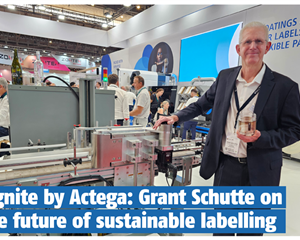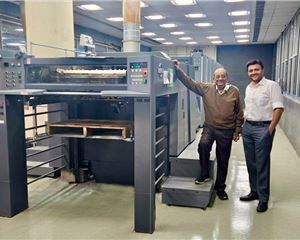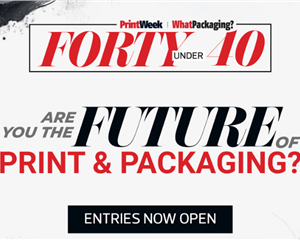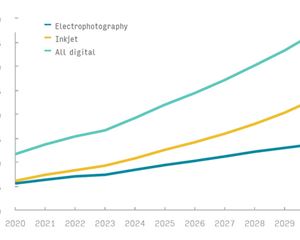The Noel D'Cunha Sunday Column - 2,60,000 tonnes of Indian inks: Do we need more?
The printing ink industry is growing. The market which was pegged at Rs 1,000-crore in 2002-03 has grown to an estimated Rs 4,500-5,000-crore. The ink makers produce an estimated 2,60,000 tonnes of printing inks and coatings per annum. This should redefine their business through new products which meet the demands of both the brand and the packager.
This Sunday Column is about the rise of the Indian printing ink industry and the momentum in the packaging industry.
29 Jul 2016 | By Noel D'Cunha
First the big numbers
The estimated market for printing ink and coating is said to be around 2,60,000 tonnes per annum.
Of this, the offset is approximately 1,40,000 tonnes, with web offset taking a little more than 50% of the share at about 80,000 tonnes. Liquid ink is estimated to be 90,000 tonnes, while metal inks are 14,000 tonnes, screen and special inks at 12,000 tonnes and UV/aqueous inks at 10,000 tonnes.
If we calculate average rates of sheetfed ink to be Rs 230 per can of a kilo, a web to be Rs 120 per kilo, and liquid inks to be Rs 180 per kilo, then the total ink market can be estimated to be in the Rs 4,500 to Rs 5,000-crore region.
Of the Rs Rs 4,500- to Rs 5,000–crore ink market, Sakata’s share would be around Rs 600-crore, Hubergroup India’s 1,000-crore, DIC Rs 800-crore, Seigwerk Rs 500-crore, Flint Rs 250-crore, Toyo Rs 165-crore and others Rs 1,500-crore.
Just to provide a perspective, the printing market in China is estimated to be USD 150-billion. In 2014, 20 top Chinese printing ink companies produced approximately 377,000 tonnes of ink in 2014, which is half of the total ink output in China.
Estimates of the size of the Asian region’s printing ink industry vary.
When PrintWeek India met Ashwani Bharadwaj at Huber's Vapi plant, he placed the Asia-Pacific market at approximately USD 5-billion, with Japan boasting of the largest portion at USD 2-billion and India at USD 750-million.
While most of the other ink manufacturing executives PrintWeek India spoke to concurred with the numbers, Gaurav Sathaye, director at United Inks and Resin, a 75-year old Indian ink maker, feels that the ink figures in India are sometimes vague and often unreliable. Sathaye points to the data on per capita consumption of ink in India, which indicates that consumption of ink in India is very low compared to developed economies. “Despite this, India is in the top 10 markets for printing inks. India is a vast country with a huge young and educated population and even with digitalisation, almost all segments in print continue to grow in India.”
The ink cost factor | Gaurav Satheye, United Inks and Varnish

Area of concern for inks is growing competition and very high emphasis being placed on the cost of ink, though it is one of the lowest value consumables in print and affects only about 3-5 % of the print cost.
Bad debt has been another threat to the entire printing industry - be it printers or consumables manufacturers or distributors. In India, the consumable business is a working capital intensive business due to longer cycles of credits.
But there is a certain realisation now. The users have come to accept that ink is a low ticket item and the onus should be on cost-effectiveness or mileage and service rather than the per kg costs and longer credits.
Trending factors
The global packaging print market is projected to grow and to reach USD 587.19-billion by 2020.
|
Ashwani Bharadwaj | Passionate about the safety aspect of printing inks or packaging inks |
|

|
Bharadwaj says, "India is projected to grow at the highest CAGR from 2015 to 2020. The reasons are a rising middle class with disposable incomes along with increased urbanisation which has contributed to an increase in preference for processed foods and ready-made meals plus the best in medical care.”
For this, low migration inks are a critical topic for converters and brand owners alike, and ink companies are working closely to meet industry needs.
Bharadwaj says consumers are talking about inks which meet stringent norms of safe food packaging.
After the regulator in India recalled the Maggi noodles, questions were raised if packaged food is good for health. And though Maggi was cleared of any infringements, the worry remains.
Vimal Mehra, director at Sakata Inx, says, “Packaged food can be better than the food stored in kirana stores. But multinational companies will not introduce global regulation unilaterally. Because of multiplier factor, packaged food poisoning and contamination is a more serious issue.”
India is not so good at it still, exporting mainly unprocessed food despite being a leader in milk, fruit, several vegetables, meat etc. “The value addition is thus very poor. Social changes, quality, and convenience will force the growth of packaged food in India,” says Mehra.
Machine efficiency is paramount | Vimal Mehra, Sakata Inx
Currently, printers who have invested in latest machines with better efficiency and results are doing well. The down trend is seen in those who have old machines which are not very cost-effective, and hence make them uncompetitive. So on one hand we see new machines coming in the country and while some printers with old machines getting no business.
Other than low migration inks, there is growth in UV inks.
Prashant Atre of Toyo Ink Arets, says, "UV curable technology has been garnering greater attention, which is why Toyo will continue to focus on developing new UV products to support the future of this strategic market."
So on product innovation, it is mainly the need for better products at cost-effective prices. For example, coatings with a better look and feel such as textured UV or soft touch coating etc. and new marketable concepts. Sathaye says, “The fact is that print needs to be innovative and interesting to survive against the threat of digital printing but also digitalisation and web media, and to fight commoditisation of print. New applications such as track and trace, RFID, security and anti-counterfeit, scented inks, etc are common and commercialised.”
Atre adds, "The world is changing faster than we think and adaptation is the only way to survive. Future is radiation curing UV, EB-electron beam and LED UV.”
Trends in Indian print | Prashant Atre, Toyo Ink Arets
In the food segment, as of now only 15% is packaged, and as the supply chain starts improving, this percentage is bound to get bigger.
I don’t see digital taking over offset in the near future. We are expecting offset to continue to grow by 12-15% year on year basis at least for next five years.
In addition, India has seeing growth in water-based inks and eco-friendly printing techniques, driven by regulatory changes and increased awareness in the industry. Water-based flexo inks for flexible packaging and the healthcare markets as areas of future growth.
Impact of digital on ink makers
|
Factors influencing print | KS Murthy, Toyo Ink  |
|
|
One of the trending factors which is a challenge to the offset industry will perhaps come from digital print, claim many experts. KS Murthy of Toyo Ink feels that when the move towards digital will happen, it is the newspaper segment that will face the challenge of growth.
But as of now domestically, certain segments of printing (especially labels and packaging), are growing at around 20% and are essentially based on conventional technologies of offset, flexo, and gravure supported by recent technology upgradations such as UV curing or EB curing or UV LED curing.
The offset is still one of the most cost effective printing technology for high-quality commercial and packaging printing for medium run jobs. The run lengths are not down to 1000 cartons or 1000 labels and till then it is difficult to rely on digital alone.
But digital printing has some huge strengths such as no makeready, short-run economics, and unique print or variable data printing. All these allow it to do certain customised and value-added products or short runs very profitably.”
But there are flip sides to digital as well. “The cost of equipment, as well as the consumables cost / "click" costs are very high to allow it to compete with the conventional technologies. To add to that the depreciation of digital presses happens the minute the first print is clicked, and technology obsolescence implies the press is almost scrap value or certainly hugely depreciated within a year or two.”
All said, it is not the replacement of offset by digital or competition with digital printing that poses a threat to offset, but in fact the combination of digital that allows a unique opportunity for slightly differentiated, customised and more value-added product.
Sathaye says he sees concepts such as one book factory using digital for short-run orders and offset for larger orders, or digital label presses for proofing or short run orders and UV Flexo for long run orders. “Organised companies are strategically inducting digital into their organisation and the benefits are seen.”
But in this game of offset versus digital, there is one danger, and that is when offset printers try to match digital rates for print runs of say 200 sheets, and in turn make a loss. This is done solely to try to hold the customer back. “Change is inevitable. It is most important for us as an industry to not fight the change nor push for the change before its time. We must be receptive to change and make the best use of it.”
And as Mehra of Sakata Inx says, the offset will not extinct because there is good growth in packaging, and ink makers will continue to back the packagers with better inks. “All major ink companies have digital inks in their range and when it’s time for digital in India, it will be brought to the country,” he concludes assuringly.
So the onus will be on printers to find niches and segments for themselves to maximise returns through a combination of new technologies with proven conventional ones.
Meeting print and business demands | RY Kamat, Hubergroup India

If you look at food packaging – there are new regulations and environmental impacts like plastic, recyclability and of course,there’s ink migration and toxicity. All these are required to be met. When it comes to flexible packaging, the talk revolves around toluene-free and ketone-free inks. These are the new challenges, and this is where from the point of view of inkmakers, brands,packagers, consumers, it becomes important.
I think the ink manufacturers are equipped to meet these challenges. We have to go with the trends.
It’s a business, the manufacturing trends do not change, it’s the technology that has to be upgraded or brought in.Obviouslythere would be some modification to the manufacturing processes likeGMPs,when new technologies are introduced to develop new products.



 Awareness about the product safety and its environmental impact is growing very rapidly. Apart from the developments in the digital area, it is the environmental concerns that will guide future product developments.
Awareness about the product safety and its environmental impact is growing very rapidly. Apart from the developments in the digital area, it is the environmental concerns that will guide future product developments.










 See All
See All